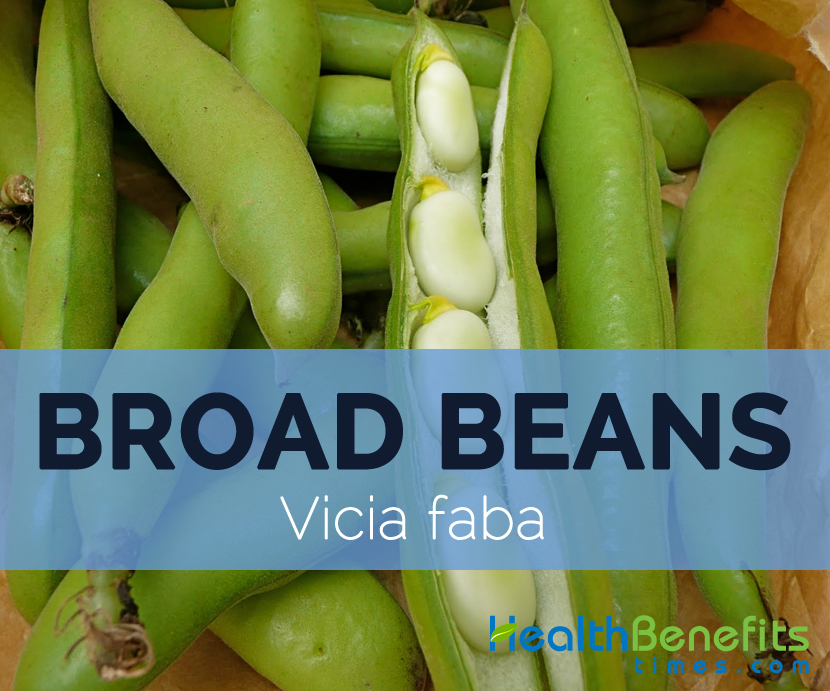History
Before it spread to Western Europe, it was cultivated for 8000 years in the Middle East. The cultivation of broad bean was started from 6,800 to 6,500 years BC. Today, broad bean is cultivated all over the world, being native to North Africa and Southwest Asia.
Plant
Broad bean is an annual stiffly erect herb up to 3-4 ft. (90-120cm) tall. The stems are tetragonous, glabrous, thick, bluish green, 6 ft. high and square shape at cross section. The plant bears bluish grey- green leaves about 10-25 cm long in a triangular to ovate shape. The leaflets are 4-10 cm long, 1-4 cm wide having the oval-elliptic shape. The flowers are white with black dots, about 1–2.5 cm long and they give pods as a fruit.
Pods
The white flowers give way to pods 5-10 cm long and 1 cm diameter. Pods are thick, broad and leathery. These may by light green when young and blackish-brown when mature, each containing 3 to 8 seeds. The seeds are ovoid to oblong shaped, 1-3 cm as a diameter ranges from white, yellow, green, pinkish-red in color. Broad beans possess sweet, tender and succulent taste with mild flavor.
Nutritional Value
Apart from their taste, it is rich in protein and fiber content. In 100 grams, Broad beans supply 62 calories and are 7.77% carbohydrates, 1.43% total fat and 9.60% protein. Broad beans are exceptional source of nutrients, providing in a 100 gram serving dietary fiber (9.47%), iron (18.75%), manganese (11.35%), phosphorus (10.43%), and vitamins such as folate (14.50%).
Calories 62 Kcal. Calories from Fat 4.5 Kcal.
| Broad bean Quick Facts | |
|---|---|
| Name: | Broad bean |
| Scientific Name: | Vicia faba |
| Origin | North Africa and Southwest Asia, also widely cultivated elsewhere. |
| Colors | White, yellow, green, pinkish-red (Seed) |
| Shapes | Ovoid-oblong; Diameter: 1-3 cm (Seed) |
| Taste | Sweet, tender and succulent |
| Calories | 62 Kcal./cup |
| Major nutrients | Vitamin C (22.00%) Iron (18.75%) Vitamin B9 (14.50%) Isoleucine (12.86%) Manganese (11.35%) |
| Health benefits | Enhance immunity, Anemia prevention, Prevents cancer, Prevents osteoporosis, Improves sleep |
| Proximity | Amount | % DV |
|---|---|---|
| Water | 83.7 g | N/D |
| Energy | 62 Kcal | N/D |
| Energy | 259 kJ | N/D |
| Protein | 4.8 g | 9.60% |
| Total Fat (lipid) | 0.5 g | 1.43% |
| Ash | 0.9 g | N/D |
| Carbohydrate | 10.1 g | 7.77% |
| Total dietary Fiber | 3.6 g | 9.47% |
| Minerals | Amount | % DV |
|---|---|---|
| Iron, Fe | 1.5 mg | 18.75% |
| Manganese, Mn | 0.261 mg | 11.35% |
| Phosphorus, P | 73 mg | 10.43% |
| Magnesium, Mg | 31 mg | 7.38% |
| Copper, Cu | 0.06 mg | 6.67% |
| Zinc, Zn | 0.47 mg | 4.27% |
| Potassium, K | 193 mg | 4.11% |
| Sodium, Na | 41 mg | 2.73% |
| Selenium, Se | 1 µg | 1.82% |
| Calcium, Ca | 18 mg | 1.80% |
| Vitamins | Amount | % DV |
|---|---|---|
| Water soluble Vitamins | ||
| Vitamin B9 (Folate, Folic acid) | 58 µg | 14.50% |
| Vitamin B1 (Thiamin) | 0.128 mg | 10.67% |
| Vitamin B3 (Niacin) | 1.2 mg | 7.50% |
| Vitamin B2 (Riboflavin) | 0.09 mg | 6.92% |
| Vitamin B6 (Pyridoxine) | 0.029 mg | 2.23% |
| Vitamin B5 (Pantothenic acid) | 0.066 mg | 1.32% |
| Vitamin C (Ascorbic acid) | 19.8 mg | 22.00% |
| Fat soluble Vitamins | ||
| Vitamin A | 14 µg | 2.00% |
| Lipids | Amount | % DV |
|---|---|---|
| Fatty acids, total saturated | 0.142 g | 0.22% |
| Fatty acids, total polyunsaturated | 0.303 g | 1.78% |
| Palmitic acid 16:00 (Hexadecanoic acid) | 0.121 g | N/D |
| Stearic acid 18:00 (Octadecanoic acid) | 0.02 g | N/D |
| Fatty acids, total monounsaturated | 0.02 g | N/D |
| Oleic acid 18:1 (octadecenoic acid) | 0.02 g | N/D |
| Linoleic acid 18:2 (octadecadienoic acid) | 0.121 g | N/D |
| Linolenic acid 18:3 (Octadecatrienoic acid) | 0.182 g | N/D |
| Lipids | Amount | % DV |
|---|---|---|
| Isoleucine | 0.215 g | 12.86% |
| Valine | 0.235 g | 11.13% |
| Tryptophan | 0.048 g | 10.91% |
| Threonine | 0.178 g | 10.11% |
| Leucine | 0.37 g | 10.01% |
| Lysine | 0.313 g | 9.36% |
| Histidine | 0.115 g | 9.33% |
| Phenylalanine | 0.195 g | 6.71% |
| Methionine | 0.037 g | 2.21% |
| Cystine | 0.066 g | N/D |
| Tyrosine | 0.168 g | N/D |
| Arginine | 0.397 g | N/D |
| Alanine | 0.195 g | N/D |
| Aspartic acid | 0.541 g | N/D |
| Glutamic acid | 0.733 g | N/D |
| Glycine | 0.197 g | N/D |
| Proline | 0.216 g | N/D |
| Serine | 0.21 g | N/D |
| Flavonoids | Amount | % DV |
|---|---|---|
| Flavan-3-ols | ||
| (+)-Catechin | 8.2 mg | N/D |
| (-)-Epigallocatechin | 4.6 mg | N/D |
| (-)-Epicatechin | 7.8 mg | N/D |
